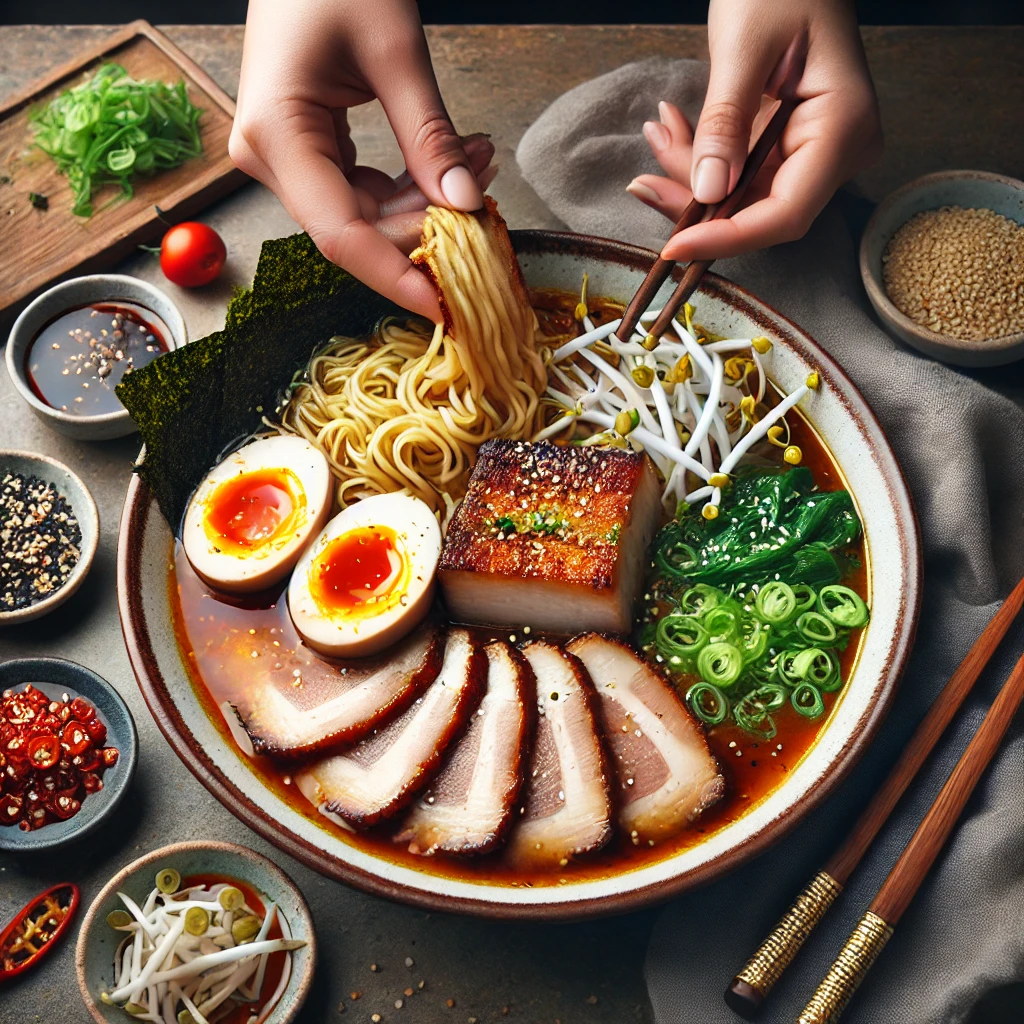
If you’ve ever enjoyed a steaming bowl of pork belly ramen at a restaurant, you know how the rich broth, tender pork belly, and chewy noodles create a magical experience.
What if I told you that you could recreate this restaurant-quality experience right at home?
This guide will walk you through the step-by-step process of making the ultimate pork belly ramen bowl that’s sure to impress your taste buds—and anyone lucky enough to share a bowl with you!
Whether you’re a seasoned home cook or new to ramen, this recipe will give you the tools to make the perfect bowl from scratch.
Let’s dive in!
Ingredients for the Ultimate Pork Belly Ramen Bowl
Pork Belly Marinade:
- 1 lb pork belly, skin on
- 3 tbsp soy sauce
- 2 tbsp mirin (Buy Mirin here)
- 1 tbsp sake (optional)
- 2 cloves garlic, minced
- 1-inch ginger, grated
- 1 tbsp brown sugar
Ramen Broth:
- 4 cups chicken broth (Buy Organic Chicken Broth here)
- 2 cups water
- 1 tbsp miso paste (Buy Miso Paste here)
- 2 tbsp soy sauce
- 1 tbsp fish sauce
- 1 tbsp sesame oil
- 1 tsp sugar
- 1 sheet kombu (dried seaweed) (Buy Kombu here)
- 1 cup shiitake mushrooms, sliced
Noodles and Toppings:
- 2 packs fresh or dried ramen noodles (Buy Ramen Noodles here)
- 2 soft-boiled eggs (Buy Egg Cooker here)
- Green onions, sliced
- Nori (seaweed sheets), cut into strips
- Bean sprouts
- Sesame seeds
- Chili oil (optional)
Step-by-Step Instructions for Restaurant-Quality Ramen
Step 1: Marinate the Pork Belly

Start by marinating the pork belly to infuse it with bold flavors. In a bowl, combine soy sauce, mirin, sake, garlic, ginger, and brown sugar. Coat the pork belly evenly and let it marinate in the refrigerator for at least 1 hour (overnight for best results).
Pro Tip: For crispy pork belly, sear it before roasting. Heat a cast-iron skillet over medium-high heat, then sear the pork belly skin-side down until crispy, about 5 minutes.
Step 2: Prepare the Broth

The key to a great ramen bowl lies in the broth. In a large pot, combine chicken broth, water, miso paste, soy sauce, fish sauce, sesame oil, sugar, and kombu. Bring it to a boil, then reduce the heat to low and let it simmer for 30-40 minutes. Add shiitake mushrooms during the last 10 minutes for an extra umami kick.
Pro Tip: Remove the kombu after simmering for 30 minutes to prevent the broth from becoming too salty.
Step 3: Cook the Pork Belly

Preheat your oven to 300°F (150°C). Remove the pork belly from the marinade, pat it dry, and place it on a baking sheet. Roast for 2-2.5 hours until tender and the fat has rendered. Once done, let the pork belly rest for 10 minutes before slicing it into thin strips.
Optional Equipment: To achieve perfect slices, use a sharp meat slicer or a high-quality chef’s knife. (Buy Meat Slicer here)
Step 4: Cook the Ramen Noodles

Cook your ramen noodles according to the package instructions. Be sure to cook them al dente, as they will soften further when added to the hot broth.
Step 5: Assemble Your Pork Belly Ramen Bowl

Now it’s time to bring everything together! Divide the cooked ramen noodles between two bowls, ladle the hot broth over them, and arrange your toppings. Add the sliced pork belly, soft-boiled eggs, green onions, bean sprouts, and nori strips. Drizzle some chili oil for a spicy kick and sprinkle sesame seeds on top.
Why This Recipe Works:
- Rich, Flavorful Broth:
The broth is the heart of any ramen dish, and this recipe ensures a rich, umami-packed base. By using a combination of miso paste, soy sauce, fish sauce, and kombu, the broth delivers layers of deep, savory flavor. The slow simmering process allows these ingredients to meld together, creating a broth that’s both hearty and complex. The addition of shiitake mushrooms further enhances the umami profile, making each spoonful irresistibly flavorful. This restaurant-quality broth is what gives the ramen its signature comforting and savory taste. - Perfectly Tender Pork Belly:
The pork belly in this recipe is marinated with a flavorful blend of soy sauce, mirin, garlic, ginger, and brown sugar, which infuses it with a sweet and savory balance. The slow-roasting method ensures the fat renders beautifully, leaving the pork belly tender on the inside with a crisp, caramelized outer layer. Searing the pork belly before roasting adds an additional crispy texture, which contrasts nicely with the soft noodles and broth. This method guarantees pork belly that melts in your mouth, just like what you’d find at a top-notch ramen shop. - Balanced Textures:
One of the key elements of great ramen is the variety of textures it offers. This recipe strikes a perfect balance between the chewy ramen noodles, tender pork belly, soft-boiled eggs with creamy yolks, and the crunch of fresh toppings like bean sprouts and green onions. Every bite offers a satisfying mix of textures that keeps you coming back for more. The addition of crispy nori strips and sesame seeds also adds a welcome contrast to the rich, smooth broth. - Customizable for Personal Preferences:
This recipe is flexible and can easily be customized to suit individual preferences. The broth can be made spicier with the addition of chili oil or red pepper flakes, or you can add more toppings like corn, bamboo shoots, or pickled ginger to suit your taste. Whether you prefer a richer broth or a lighter one, you can adjust the flavor by adding more miso or soy sauce. The ability to personalize the dish makes it even more appealing, as it caters to a wide range of palates. - Restaurant-Quality Results at Home:
Achieving restaurant-quality ramen at home can seem daunting, but this recipe breaks it down into simple, manageable steps. From marinating and roasting the pork belly to creating a rich, flavorful broth, every aspect of this recipe is designed to be easy to follow, even for beginner cooks. The final dish rivals what you’d get at a high-end ramen restaurant, without the need to leave your kitchen. It’s a recipe that delivers gourmet results with a bit of patience and attention to detail. - Comforting and Satisfying:
Ramen is the ultimate comfort food, and this pork belly ramen bowl hits all the right notes. The rich broth warms you from the inside out, while the tender pork belly and fresh noodles make for a deeply satisfying meal. Whether you’re enjoying it on a cold day or just craving something hearty and indulgent, this dish is the perfect balance of flavors and textures to provide comfort and joy in every bowl. - Visual Appeal:
The vibrant colors and beautiful presentation of this pork belly ramen bowl make it not only delicious but also visually appealing. The bright green onions, golden soft-boiled eggs, deep red chili oil, and the beautifully browned pork belly create a feast for the eyes. This dish is as stunning to look at as it is to eat, making it a great option for impressing guests or adding a gourmet touch to your home-cooked meal.
Storing and Reheating Your Pork Belly Ramen Bowl

Once you’ve created your delicious pork belly ramen, you might have leftovers. Here’s how to store and reheat everything while maintaining the integrity of the dish.
- Storing the Broth: Store the broth in an airtight container in the fridge for Store for up to 3 days in the refrigerator or freeze for up to 3 months.. To prevent cloudiness when freezing, let the broth cool completely before transferring it to the freezer.
- Storing the Noodles: Keep the noodles separate from the broth to avoid them getting soggy. Rinse them in cold water, then toss them with a little sesame oil to prevent sticking. Store in an airtight container in the fridge for up to 2 days.
- Storing the Pork Belly: Slice the cooked pork belly and store it in a separate container in the fridge for up to 3 days.
Reheating Tips:
- Reheating Broth: Warm the broth on low heat until simmering. If it thickened too much, add a splash of water or broth to loosen it.
- Reheating Pork Belly: Reheat the pork belly by pan-searing it on medium heat until it’s heated through and crispy on the outside. This keeps the texture perfect!
- Reheating Noodles: Rinse the noodles in hot water for 30 seconds to reheat without overcooking them.
Essential Equipment for Making the Perfect Ramen Bowl

To get restaurant-quality ramen results at home, having the right kitchen equipment makes all the difference. Here are some recommended tools to elevate your ramen-making experience:
- Ramen Pot: A deep, heavy-bottomed pot is ideal for simmering the broth for long periods. (Buy this ramen pot here.)
- Chef’s Knife: A sharp knife is key to slicing your pork belly into even, thin slices. (Buy a chef’s knife here.)
- Strainer: Use a fine-mesh strainer to skim off impurities from the broth as it simmers. (Buy this fine-mesh strainer here.)
- Noodle Basket: These baskets make boiling and draining ramen noodles easy, ensuring they cook perfectly. (Buy a noodle basket here.)
- Ramen Bowls and Chopsticks: Presentation matters! Serve your ramen in large, deep bowls and add a pair of stylish chopsticks for an authentic touch. (Buy ramen bowls and chopsticks here.)
Having the right equipment not only makes cooking easier but also enhances the overall presentation and enjoyment of your ramen.
Common Ramen-Making Mistakes and How to Avoid Them
Making ramen can be an art, and it’s easy to make a few mistakes:
- Overcooking the Noodles: Ramen noodles cook quickly, so make sure to cook them al dente (slightly firm). Follow the package instructions closely, and avoid leaving the noodles in the broth for too long after cooking to prevent them from turning mushy.
- Broth Too Salty: If your broth is too salty, it could be because you left the kombu in for too long or added too much soy sauce. Dilute it with a little more water or low-sodium chicken broth to balance the flavors.
- Soggy Pork Belly: If your pork belly becomes soggy when reheating, make sure to re-crisp it by searing it in a hot pan instead of microwaving it. This keeps the delicious contrast between tender meat and crispy skin.
- Not Skimming the Broth: While simmering the broth, make sure to skim off any impurities that rise to the surface. This helps keep the broth clear and improves the flavor.
By avoiding these mistakes, you can create a flawless bowl of ramen every time!
Health Benefits of Ingredients in Pork Belly Ramen

While ramen is often considered indulgent comfort food, many of the ingredients in this dish have great nutritional value. Let’s take a look at the benefits:
- Pork Belly: While pork belly is rich in fat, it’s also an excellent source of protein and essential B vitamins. Opt for smaller portions of pork belly to balance indulgence with nutrition.
- Shiitake Mushrooms: Shiitake mushrooms are a powerhouse of nutrients, containing fiber, protein, and various vitamins like B6. They are also linked to immune-boosting properties and may help lower cholesterol.
- Miso Paste: Miso is fermented and full of probiotics, which promote gut health. It’s also a good source of essential minerals like zinc and manganese.
- Seaweed (Nori): Seaweed is low in calories but packed with important nutrients like iodine, which supports thyroid health, and various antioxidants.
- Eggs: Soft-boiled eggs add a boost of protein and healthy fats to your ramen bowl, making it more filling and nutritious.
Incorporating these ingredients in moderation allows you to enjoy a balanced meal that satisfies both your taste buds and your health goals
Ingredient Substitutions and Dietary Modifications
Here are some easy ways to customize this recipe to fit different dietary needs or preferences:
- Gluten-Free Option: Replace the ramen noodles with gluten-free noodles or rice noodles, and use gluten-free soy sauce to keep the dish friendly for gluten-sensitive eaters.
- Vegan/Vegetarian Alternative: Replace pork belly with crispy tofu or jackfruit for a plant-based protein option. Use vegetable broth instead of chicken broth, and omit fish sauce in favor of extra soy sauce or tamari for added flavor.
- Lower-Sodium Ramen: Use low-sodium chicken broth and reduce the amount of soy sauce to create a lower-sodium version. You can also add more water to the broth to balance out the saltiness.
- Lower-Calorie Option: Opt for leaner cuts of pork or even chicken breast in place of pork belly. Using zucchini noodles instead of ramen noodles can also cut down on calories while maintaining a delicious texture.
These substitutions make the dish accessible to a wider audience without sacrificing flavor or quality.
Best Side Dishes and Drinks to Serve with Pork Belly Ramen

To round out your meal, here are some side dishes and drinks that perfectly complement your pork belly ramen bowl:
- Gyoza (Japanese Dumplings): These crispy and juicy dumplings make a fantastic side dish for ramen. They can be pan-fried or steamed for a lighter option. (Get a great gyoza recipe here.)
- Cucumber Salad: A light, refreshing cucumber salad with a tangy sesame dressing provides a crisp contrast to the rich ramen broth. It’s the perfect palate cleanser.
- Japanese Pickles (Tsukemono): Serve pickled vegetables on the side for a punch of acidity and brightness to cut through the richness of the ramen.
- Sake or Japanese Beer: Pair your ramen with a cold glass of Japanese beer (like Asahi or Sapporo) or a small serving of sake. The dry, crisp flavors of these drinks balance out the richness of the pork belly.
- Green Tea: For a non-alcoholic option, a hot cup of green tea is an excellent choice, as it aids digestion and refreshes the palate.
Have you tried this recipe?
Leave a comment below with your feedback and tips!
9. How to Eat Ramen Like a Pro
Eating ramen has its own set of etiquette and traditions, especially in Japan. Here’s how to enjoy your ramen like a pro:
- Slurping Is Encouraged: In Japan, slurping your noodles isn’t just acceptable, it’s a sign that you’re enjoying your meal. Slurping helps cool the noodles and enhances the flavor of the broth by aerating it.
- Eat the Noodles Quickly: Ramen noodles are best when they’re still firm. In Japan, ramen is meant to be eaten quickly to avoid the noodles soaking up too much broth and becoming soggy.
- Chopsticks and Spoons: Use chopsticks to lift the noodles and a spoon to sip the broth. You can also use your spoon to gather some toppings with each bite of noodles.
- Don’t Drink All the Broth: It’s common practice to leave a little broth at the bottom of your bowl. While you’re welcome to finish it, Japanese tradition often leaves some behind as a sign of being full.
By following these simple tips, you can enhance your ramen-eating experience and enjoy your bowl the way it’s meant to be!
Recipe Card
Pork Belly Ramen Bowl Recipe: Your Guide to Restaurant-Quality Ramen

Pork Belly Ramen Bowl Recipe: Your Guide to Restaurant-Quality Ramen
Ingredients
Ingredients
For the Pork Belly Marinade:
- 1 lb pork belly
- 3 tbsp soy sauce
- 2 tbsp mirin
- 1 tbsp sake optional
- 2 cloves garlic minced
- 1- inch ginger grated
- 1 tbsp brown sugar
For the Ramen Broth:
- 4 cups chicken broth
- 2 cups water
- 1 tbsp miso paste
- 2 tbsp soy sauce
- 1 tbsp fish sauce
- 1 tbsp sesame oil
- 1 tsp sugar
- 1 sheet kombu
- 1 cup shiitake mushrooms sliced
- For the Noodles and Toppings:
- 2 packs ramen noodles
- 2 soft-boiled eggs
- Green onions sliced
- Nori sliced
- Bean sprouts
- Sesame seeds
- Chili oil optional
Instructions
Instructions
- Marinate pork belly for 1 hour in soy sauce, mirin, sake, garlic, ginger, and brown sugar.
- Sear pork belly, then roast at 300°F for 2-2.5 hours.
- Prepare the broth by simmering chicken broth, miso paste, soy sauce, fish sauce, sesame oil, and kombu for 30 minutes.
- Cook the ramen noodles according to package instructions.
- Assemble bowls by placing noodles, broth, pork belly slices, and toppings. Serve hot.
Nutritional Info (per serving):
- Calories: 850 kcal
- Protein: 35g
- Carbs: 45g
- Fat: 50g
- Fiber: 4g
Notes
Conclusion
Now that you’ve mastered this pork belly ramen bowl recipe, you can enjoy restaurant-quality ramen anytime without leaving your kitchen.
Whether you’re cooking for yourself or impressing guests, this dish will become a go-to favorite.
Don’t forget to share your ramen bowl creations on social media and tag us—we’d love to see how it turns out!
Buy the Tools You Need to Make This Recipe:
By following this guide, you’ll be well on your way to mastering pork belly ramen at home—enjoy!
Frequently Asked Questions (FAQs)
Q: Can I use store-bought ramen noodles?
A: Absolutely! Fresh ramen noodles are ideal, but dried noodles work perfectly for this recipe too.
Q: How can I make the broth richer?
A: You can simmer the broth longer or add some pork bones during the cooking process for extra depth of flavor.
Q: What’s the best method for making the perfect soft-boiled egg?
A: Simmer eggs for exactly 7 minutes, then transfer them to an ice bath for a few minutes to stop the cooking process.
Try These Other Delicious Recipes:
BBQ Grilled Pork Belly with Smoky Spices: A Flavor Explosion for Your Grill
Sweet and Sticky Asian-Style Pork Belly: Your New Go-To Recipe for Dinner
As an Amazon Associate I earn from qualifying purchases.



